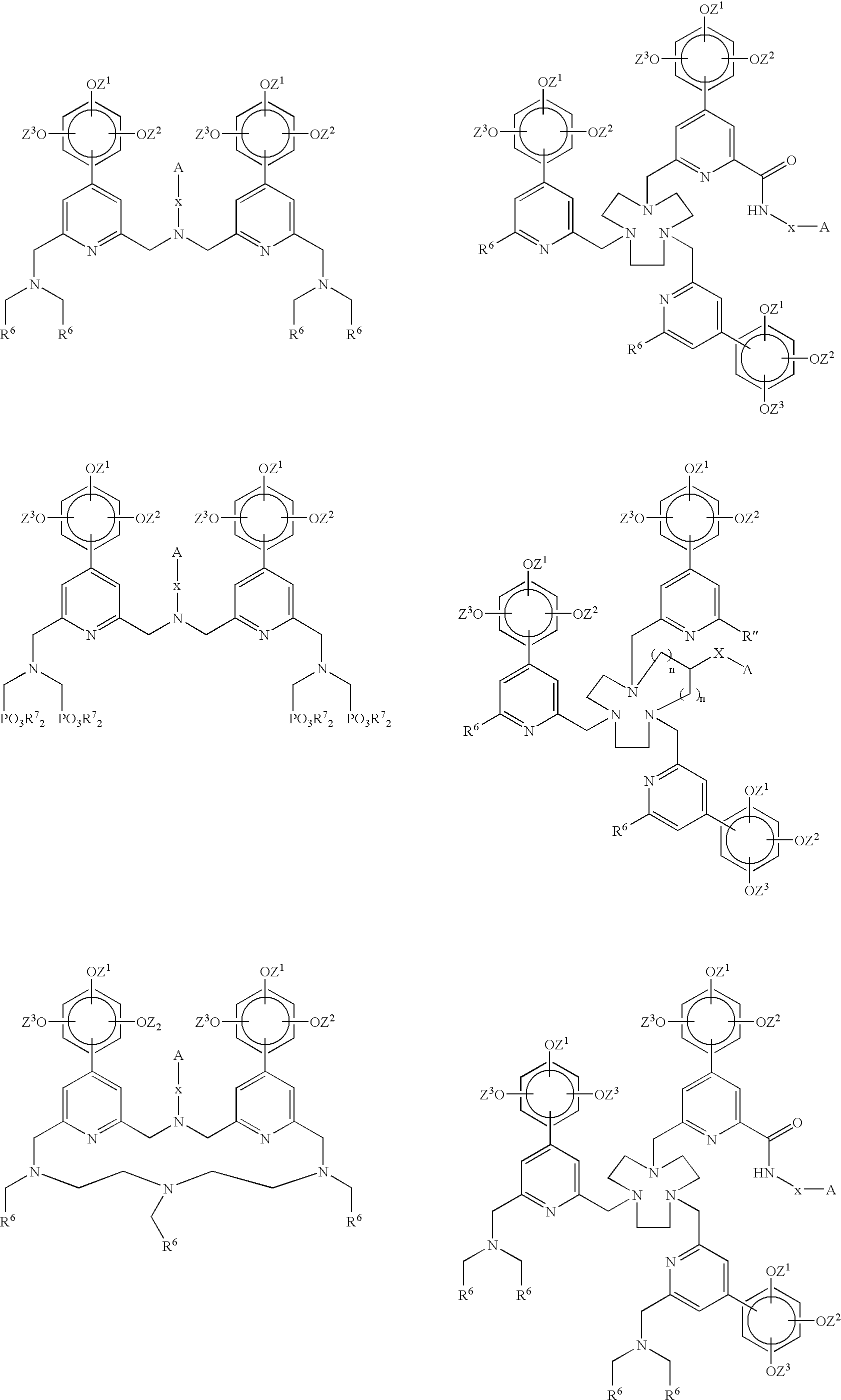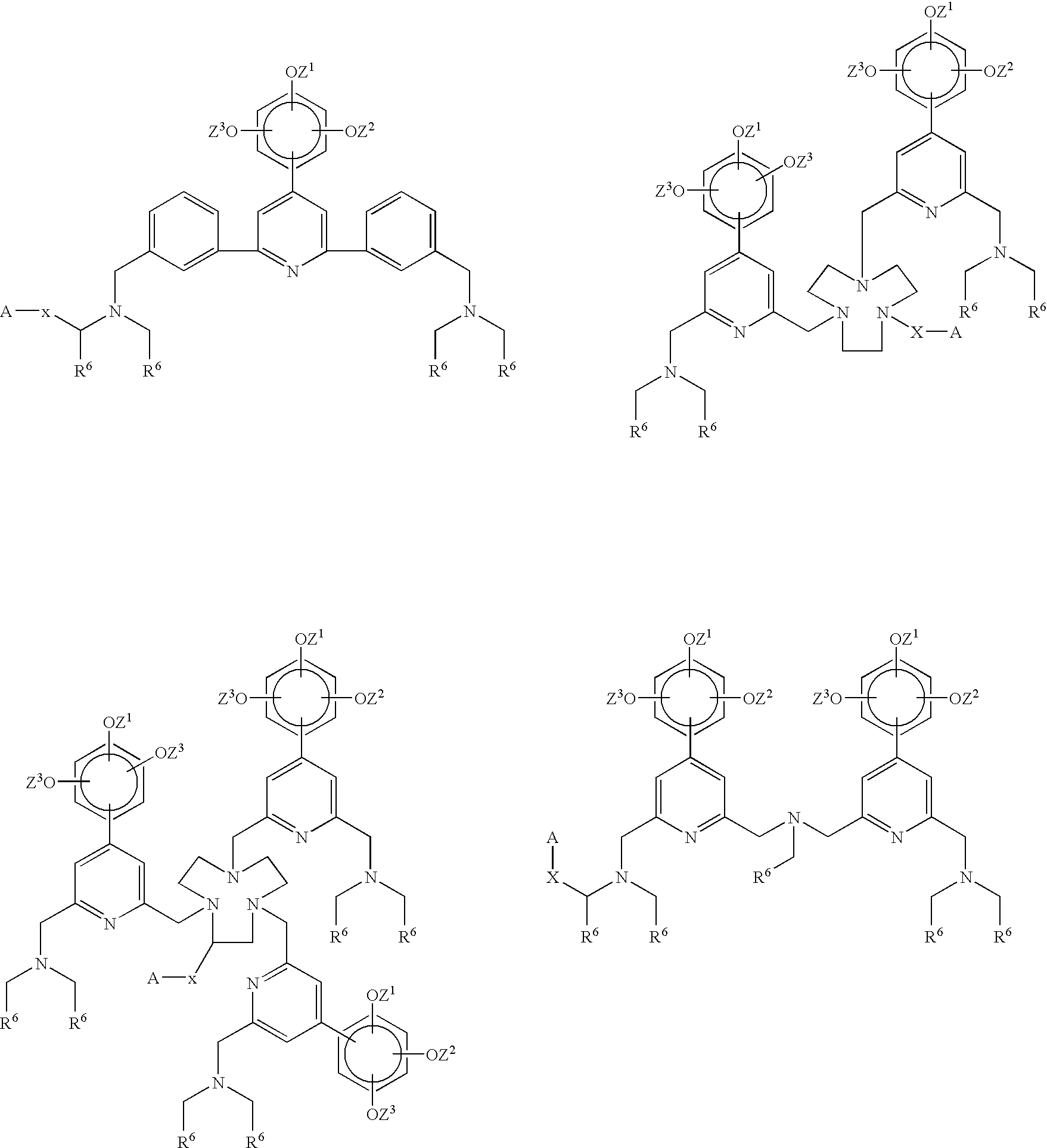Novel chelating agents and highly luminescent and stable chelates and their use
a chelating agent and luminescent technology, applied in the direction of sugar derivatives, biocide, plant growth regulators, etc., can solve the problems of inability to avoid laborious purification procedures, inability to isolate and characterize desired biomolecule conjugates, and often practically impossible, and achieve the goal of avoiding the solution phase labeling of large biomolecules, such as proteins
- Summary
- Abstract
- Description
- Claims
- Application Information
AI Technical Summary
Benefits of technology
Problems solved by technology
Method used
Image
Examples
example 1
The synthesis of tetra(tertbutyl) 2,2′,2″,2′″-{[6-N-(4-methoxytrityl)aminohexyl-imino]bis(methylene)bis[4-(2,4,6-trimethoxyphenyl)pyridine-6,2-diyl]bis (methylenenitrilo)}tetrakis(acetate) 1.
[0063] Tetra(tert-butyl) 2,2′,2″,2′″-{[6-N-(4-methoxytrityl)hexylimino]bis(methylene)bis-(4-bromopyridine-6,2-diyl)bis(methylenenitrilo)}tetrakis(acetate) (4.0 g, 2.4 mmol) and trimethoxyphenylboronic acid (1.1 g, 5.3 mmol) were dissolved in dry DMF (50 mL) and Cs2CO3 (2.0 g, 6.0 mmol) and Pd(PPh3)4 (0.1 g, 96 μmol) were added. After stirring overnight at 95°, trimethoxyphenylboronic acid (0.5 g, 2.4 mmol), Cs2CO3 (0.79 g, 2mmol) and Pd(PPh3)4 (50 mg, 43 mmol) were added. After overnight reaction the mixture was cooled to room temperature, filtered and evaporated. The mixture was dissolved in CH2Cl2 and washed with water (2·40 ml). The product was purified by flash chromatography (silica gel, petroleum ether (40-60°) / AcOEt / TEA 5:2:1, v / v / v). Yield was 3.1 g (90%). IR (film): 1737 (C═O), 1128 (C...
example 2
The Synthesis of Tetra(tert-butyl) 2,2′,2″,2′″-{(6-aminohexylimino)bis(methylene)-bis[4-(2,4,6-trimethoxyphenyl)pyridine-6,2-diyl]bis(methylenenitrilo)}tetrakis-(acetate) 2
[0064] Compound 1 (1.0 g, 0.7 mmol) was dissolved in dichloromethane (25 mL) and trifluoroacetic acid (0.25 mL) was added. After stirring for 4 hours at ambient temperature the mixture was washed with sat. NaHCO3 (2·50 mL). The organic phase was dried over Na2SO4, filtered and evaporated. The product was purified by flash chromatography (silica gel, petroleum ether (40-60°) / AcOEt / TEA 5:5:1, 2:5:1 and finally 10% MeOH, 1% TEA in CH2Cl2). Yield was 0.60 g (74%). IR (film): 1730 (C═O), 1128 (C—O). ESI-MS: [M+H]+ 1145.7 calc. for C82H109N6O15+ 1145.7; [M+2H]2+ 573.3, calc. 573.3.
example 3
The Synthesis of the allyl Protected Oligopeptide Labeling Reactant 3
[0065] Compound 2 (0.55 g, 0.48 mmol) was dissolved in dry dichloromethane (5 mL). DCC (0.11 g, 0.53 mmol) and Fmoc-Glu-OAII (0.20 g, 0.48 mmol) were added, and the mixture was stirred overnight at room temperature. DCU formed was filtered off and the filtrate was concentrated in vacuo. Purification on silica gel (10% MeOH in dichloromethane) yielded the title compound as a solid (300 mg). ESI-MS: [M+H]+ 1536.8 calc. for C85H114N7O19+ 1536.8.
PUM
 Login to View More
Login to View More Abstract
Description
Claims
Application Information
 Login to View More
Login to View More - Generate Ideas
- Intellectual Property
- Life Sciences
- Materials
- Tech Scout
- Unparalleled Data Quality
- Higher Quality Content
- 60% Fewer Hallucinations
Browse by: Latest US Patents, China's latest patents, Technical Efficacy Thesaurus, Application Domain, Technology Topic, Popular Technical Reports.
© 2025 PatSnap. All rights reserved.Legal|Privacy policy|Modern Slavery Act Transparency Statement|Sitemap|About US| Contact US: help@patsnap.com



